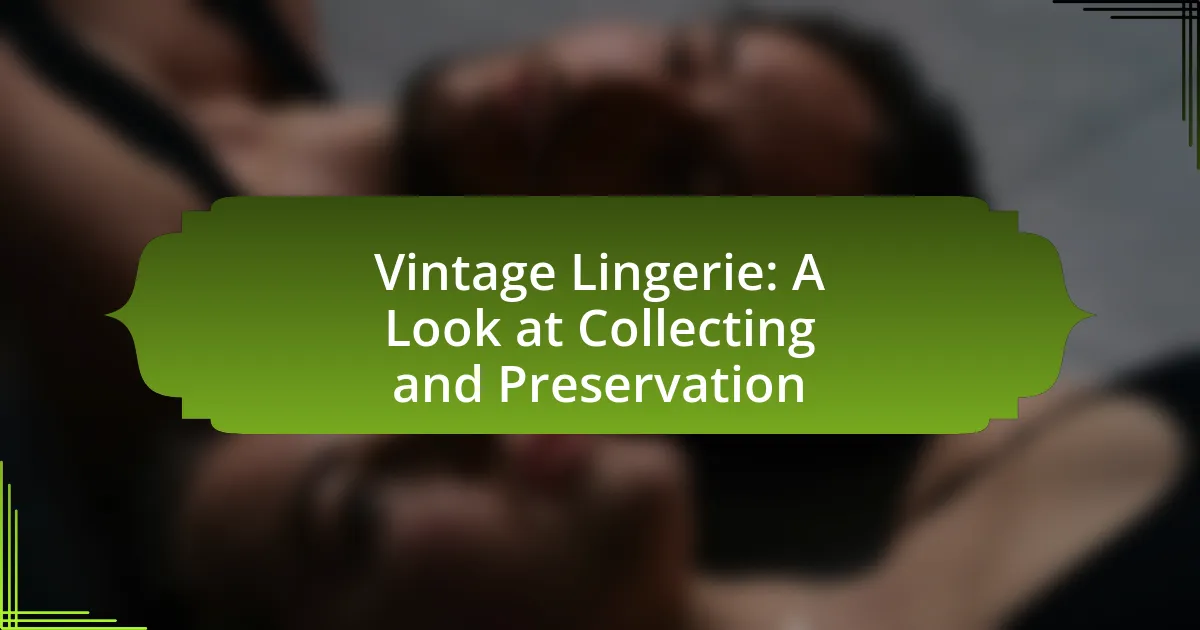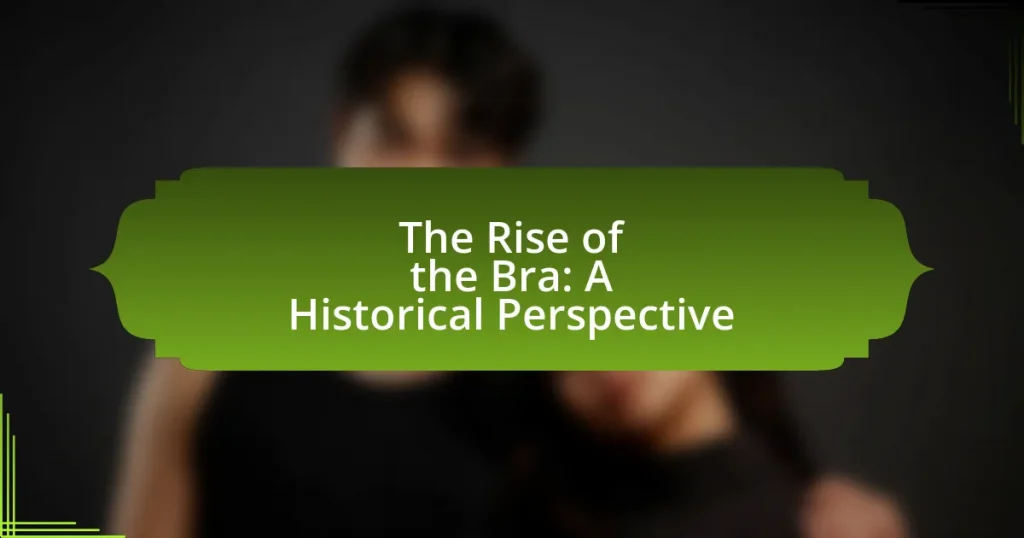Vintage lingerie encompasses undergarments produced from the 1920s to the 1980s, showcasing unique styles, fabrics, and craftsmanship reflective of the fashion trends of those decades. The article explores the evolution of vintage lingerie, highlighting key styles from various eras, cultural influences on design, and the factors contributing to its collectibility. It also provides best practices for collectors, including identification of authentic pieces, preservation techniques, and common pitfalls to avoid. Additionally, the article discusses resources for further learning and ways to connect with other enthusiasts in the vintage lingerie community.

What is Vintage Lingerie?
Vintage lingerie refers to undergarments that were produced between the 1920s and the 1980s, characterized by their unique styles, fabrics, and craftsmanship reflective of the fashion trends of those eras. This category includes items such as corsets, slips, bras, and panties, often made from materials like silk, lace, and satin, which were popular during those decades. The significance of vintage lingerie lies in its historical context, showcasing the evolution of women’s fashion and societal norms regarding femininity and sexuality. Collectors often seek vintage lingerie for its aesthetic appeal, rarity, and the craftsmanship that distinguishes it from contemporary designs.
How did vintage lingerie evolve over the decades?
Vintage lingerie evolved significantly over the decades, reflecting changes in fashion, societal norms, and technology. In the 1920s, flapper styles introduced more relaxed silhouettes, moving away from the restrictive corsets of the previous era, while the 1930s saw the introduction of bias-cut designs that emphasized natural body shapes. The 1940s brought functional yet feminine styles due to wartime fabric rationing, leading to the popularity of simpler, utilitarian pieces.
In the 1950s, lingerie became more glamorous with the rise of the hourglass figure, featuring structured bras and girdles that enhanced curves. The 1960s and 1970s marked a shift towards liberation, with the introduction of more comfortable and less restrictive designs, including the bralette and the rise of the mini skirt, which influenced lingerie styles. By the 1980s and 1990s, lingerie became a fashion statement, with bold colors, lace, and designer labels gaining prominence, reflecting a blend of sensuality and empowerment.
This evolution is evidenced by the transition from functional undergarments to fashion items, as seen in the increasing variety of styles and materials used throughout the decades, including silk, lace, and synthetic fabrics. The changing perceptions of femininity and body image also played a crucial role in shaping lingerie trends, making vintage lingerie a rich area for collectors and preservationists.
What key styles define vintage lingerie from different eras?
Key styles that define vintage lingerie from different eras include the corsets and bustiers of the Victorian era, which emphasized an hourglass figure; the flapper-style lingerie of the 1920s, characterized by loose-fitting silhouettes and boyish shapes; the bullet bras and girdles of the 1950s, which created a pointed bust and cinched waist; and the lace and sheer fabrics of the 1970s, reflecting a more liberated and sensual aesthetic. Each era’s lingerie reflects the prevailing fashion trends and societal attitudes towards femininity and sexuality, making them significant in the history of women’s clothing.
How do cultural influences shape the design of vintage lingerie?
Cultural influences significantly shape the design of vintage lingerie by reflecting societal norms, values, and aesthetics of their respective eras. For instance, the Victorian era emphasized modesty and structure, leading to the creation of corsets that shaped the body into an hourglass figure, which was deemed desirable at the time. In contrast, the flapper era of the 1920s embraced a more liberated approach, resulting in looser, more comfortable designs that allowed for greater movement and reflected the changing roles of women in society. Additionally, the post-World War II period saw the introduction of more sensual and glamorous styles, influenced by Hollywood and the rise of consumer culture, which celebrated femininity and allure. These historical contexts illustrate how cultural shifts directly impact the aesthetics and functionality of vintage lingerie designs.
Why is vintage lingerie considered collectible?
Vintage lingerie is considered collectible due to its historical significance, craftsmanship, and rarity. Many pieces reflect the fashion trends and societal norms of their respective eras, making them valuable artifacts for collectors. For instance, items from renowned brands like Victoria’s Secret or unique designs from the mid-20th century can fetch high prices at auctions, illustrating their desirability. Additionally, the intricate details and quality materials used in vintage lingerie often surpass modern production standards, further enhancing their appeal among collectors.
What factors contribute to the value of vintage lingerie?
The value of vintage lingerie is primarily influenced by factors such as rarity, condition, brand, and historical significance. Rarity plays a crucial role; items produced in limited quantities or from discontinued lines tend to be more valuable. The condition of the lingerie, including the absence of damage or wear, significantly affects its market price, with pristine pieces commanding higher values. Brand reputation also contributes; well-known designers or luxury labels often enhance desirability and value. Additionally, historical significance, such as pieces associated with specific cultural movements or events, can elevate the worth of vintage lingerie, as collectors seek items that tell a story or represent a particular era.
How does rarity affect the desirability of vintage lingerie pieces?
Rarity significantly increases the desirability of vintage lingerie pieces. Collectors and enthusiasts often seek unique items that are not widely available, making rare pieces more sought after. For instance, limited production runs or discontinued styles from renowned brands can command higher prices and attract more attention in the market. Historical significance also plays a role; lingerie that reflects specific fashion trends or cultural moments can become particularly desirable due to its rarity. This phenomenon is supported by auction results, where rare vintage lingerie often sells for multiples of its original retail price, demonstrating the strong correlation between rarity and desirability in this niche market.

What are the best practices for collecting vintage lingerie?
The best practices for collecting vintage lingerie include thorough research, careful inspection, proper storage, and ethical sourcing. Collectors should familiarize themselves with different styles, fabrics, and historical contexts to make informed purchases. Inspecting items for condition, including seams, tags, and any signs of wear, ensures quality. Proper storage involves using acid-free materials and avoiding direct sunlight to prevent damage. Additionally, sourcing from reputable dealers or auctions helps maintain ethical standards in the collection process. These practices are essential for preserving the integrity and value of vintage lingerie.
How can collectors identify authentic vintage lingerie?
Collectors can identify authentic vintage lingerie by examining labels, materials, and construction techniques. Authentic vintage lingerie typically features labels from well-known brands that were active during the specific era, such as Playtex or Maidenform, which can help date the piece. Additionally, the materials used, such as silk, lace, or cotton, should reflect the quality and style of the time period, as synthetic fabrics became more common in later decades. Construction techniques, including the presence of hand-sewn details or specific stitching patterns, can also indicate authenticity, as mass production methods were not as prevalent in earlier decades. Collectors should also be aware of the typical styles and silhouettes that were popular in different eras, such as the high-waisted styles of the 1940s or the more revealing designs of the 1970s, to further validate the authenticity of the lingerie.
What labels or tags should collectors look for?
Collectors should look for labels or tags that indicate the brand, size, and material of vintage lingerie. Notable brands such as Victoria’s Secret, Playtex, and Maidenform often have specific tags that can help authenticate the piece and provide context regarding its era. Additionally, tags that specify materials like silk, lace, or nylon can enhance the value and desirability of the item. Collectors should also pay attention to care labels, as these can indicate the age and authenticity of the garment, with older pieces often lacking standardized care instructions.
How can one differentiate between reproduction and original pieces?
To differentiate between reproduction and original pieces of vintage lingerie, one should examine specific characteristics such as labels, materials, and construction techniques. Original pieces often feature labels from the time period they were produced, while reproductions may have modern labels or lack historical accuracy. Additionally, original lingerie typically uses vintage fabrics and construction methods, which can differ significantly from contemporary manufacturing practices. For instance, original pieces may have hand-stitched seams or unique embellishments that are not replicated in reproductions. These distinctions help collectors identify authentic vintage lingerie versus modern reproductions.
What are the common pitfalls in vintage lingerie collecting?
Common pitfalls in vintage lingerie collecting include misidentifying materials, overlooking condition issues, and failing to verify authenticity. Misidentifying materials can lead collectors to overpay for items that are not truly vintage or made from inferior fabrics. Condition issues, such as stains, tears, or missing components, can significantly reduce an item’s value, yet collectors may overlook these details during purchase. Additionally, failing to verify authenticity can result in acquiring reproductions instead of genuine vintage pieces, which diminishes the collection’s integrity. Collectors should research and educate themselves on these aspects to avoid these common mistakes.
What mistakes should new collectors avoid?
New collectors should avoid overpaying for items by not conducting thorough research on market values. Many new collectors often lack knowledge about pricing trends, leading them to make impulsive purchases without understanding the true worth of vintage lingerie. For instance, a 2021 study by the Vintage Fashion Guild highlighted that prices for vintage lingerie can vary significantly based on brand, condition, and rarity, emphasizing the importance of informed buying decisions. Additionally, new collectors should refrain from neglecting proper storage and preservation techniques, as improper care can lead to irreversible damage, diminishing the value of their collection.
How can one ensure they are paying a fair price?
To ensure one is paying a fair price for vintage lingerie, it is essential to conduct thorough market research. This involves comparing prices from various reputable sources, such as online marketplaces, vintage shops, and auction sites, to establish a price range for similar items. Additionally, understanding the condition, brand, and rarity of the lingerie can significantly influence its value. For instance, a vintage piece from a well-known designer in excellent condition will typically command a higher price than a lesser-known brand or one with visible wear. According to a 2021 study by the Vintage Fashion Guild, items that are well-documented and authenticated tend to sell for 20-30% more than those without provenance, highlighting the importance of verifying authenticity to ensure a fair price.

How can vintage lingerie be preserved effectively?
To preserve vintage lingerie effectively, it is essential to store it in a cool, dry, and dark environment, away from direct sunlight and humidity. This method prevents fabric degradation and discoloration, which are common issues for delicate materials like silk and lace. Additionally, using acid-free tissue paper to wrap each piece helps maintain its shape and prevents creasing. Historical preservation practices indicate that maintaining a stable temperature and humidity level can significantly extend the lifespan of textiles, as fluctuations can lead to mold growth and fabric deterioration.
What are the best methods for cleaning vintage lingerie?
The best methods for cleaning vintage lingerie include hand washing with a gentle detergent, using cold water, and air drying. Hand washing minimizes the risk of damage that can occur in a washing machine, while a gentle detergent prevents harsh chemicals from degrading delicate fabrics. Cold water is essential as hot water can cause shrinkage or color fading. Air drying, rather than using a dryer, helps maintain the integrity of the fabric and shape. These methods are widely recommended by textile conservators and vintage clothing experts to preserve the quality and longevity of vintage lingerie.
How does fabric type influence cleaning techniques?
Fabric type significantly influences cleaning techniques due to varying sensitivities and care requirements of different materials. For instance, delicate fabrics like silk and lace require gentle cleaning methods, such as hand washing with mild detergents, to prevent damage. In contrast, sturdier fabrics like cotton can withstand machine washing and higher temperatures. Additionally, synthetic fabrics may require specific detergents to avoid degradation. The cleaning method must align with the fabric’s characteristics to maintain its integrity and appearance, as improper cleaning can lead to fading, shrinking, or structural damage.
What products are safe to use on delicate vintage fabrics?
Safe products for delicate vintage fabrics include pH-neutral detergents, gentle fabric cleaners specifically designed for delicate textiles, and distilled water for rinsing. These products are formulated to minimize damage to fragile fibers, such as silk or lace, which are commonly found in vintage lingerie. For instance, using a pH-neutral detergent prevents the breakdown of fibers that can occur with harsher soaps. Additionally, products like Eucalan or The Laundress Delicate Wash are recommended by textile conservators for their gentle cleaning properties.
How should vintage lingerie be stored to prevent damage?
Vintage lingerie should be stored in a cool, dry, and dark environment to prevent damage. This storage method minimizes exposure to light, humidity, and temperature fluctuations, which can degrade delicate fabrics and cause discoloration. Additionally, using acid-free tissue paper to wrap each piece helps maintain its shape and prevents creasing. Storing lingerie in breathable cotton or linen bags rather than plastic containers allows for air circulation, reducing the risk of mold and mildew. These practices are supported by textile conservation guidelines, which emphasize the importance of proper storage conditions for preserving historical garments.
What storage conditions are ideal for preserving vintage pieces?
Ideal storage conditions for preserving vintage pieces include a cool, dry environment with stable temperatures between 60-70°F and humidity levels around 40-50%. These conditions prevent mold growth and material degradation. Additionally, vintage items should be stored in acid-free boxes or containers to avoid chemical reactions that can cause deterioration. Light exposure should be minimized, as UV rays can fade colors and weaken fabrics. Proper storage techniques, such as using padded hangers for garments and avoiding overcrowding, further protect the integrity of vintage pieces.
How can one protect vintage lingerie from pests and environmental factors?
To protect vintage lingerie from pests and environmental factors, one should store the items in acid-free tissue paper within breathable cotton or linen bags, avoiding plastic which can trap moisture and promote mold. Additionally, maintaining a stable, cool, and dry environment with low humidity levels is crucial, as high humidity can attract pests like moths. Regularly inspecting the lingerie for signs of damage or pest activity, and using natural repellents such as lavender sachets can further deter pests. These methods are supported by textile preservation guidelines from institutions like the American Institute for Conservation, which emphasize the importance of proper storage conditions to prolong the lifespan of delicate fabrics.
What tips can enhance the vintage lingerie collecting experience?
To enhance the vintage lingerie collecting experience, collectors should focus on researching the history and styles of lingerie from different eras, as this knowledge helps in identifying authentic pieces and understanding their value. Engaging with online communities and forums dedicated to vintage lingerie can provide insights, tips, and access to rare finds, fostering a sense of connection among collectors. Additionally, proper storage and preservation techniques, such as using acid-free materials and avoiding direct sunlight, are crucial for maintaining the integrity of delicate fabrics. Collectors should also consider attending vintage fairs and auctions, where they can discover unique items and network with other enthusiasts, further enriching their collecting journey.
How can collectors connect with other vintage lingerie enthusiasts?
Collectors can connect with other vintage lingerie enthusiasts through online forums, social media groups, and specialized events. Online platforms like Facebook and Instagram host dedicated groups where members share collections, discuss trends, and exchange tips. Additionally, attending vintage fairs, expos, and local meetups provides opportunities for face-to-face interactions and networking. These methods are effective as they foster community engagement and allow collectors to share knowledge and resources, enhancing their collecting experience.
What resources are available for learning more about vintage lingerie?
Books, online courses, and dedicated websites are valuable resources for learning about vintage lingerie. Notable books include “The History of Lingerie” by C. Wilcox, which provides historical context and design evolution, and “Vintage Lingerie: 50 Patterns from the 1920s to the 1980s” by the same author, which offers practical insights into vintage lingerie patterns. Online platforms like Skillshare and Coursera offer courses on fashion history, including segments on lingerie. Websites such as Vintage Lingerie and The Lingerie Addict provide articles, guides, and community forums for enthusiasts. These resources collectively enhance understanding and appreciation of vintage lingerie, supported by historical documentation and expert insights.



